engine oil YAMAHA XSR 900 2018 Owners Manual
[x] Cancel search | Manufacturer: YAMAHA, Model Year: 2018, Model line: XSR 900, Model: YAMAHA XSR 900 2018Pages: 104, PDF Size: 7.56 MB
Page 6 of 104

Table of contentsSafety information........................... 1-1
Description ....................................... 2-1
Left view ......................................... 2-1
Right view ....................................... 2-2
Controls and instruments................ 2-3
Instrument and co ntrol functions... 3-1
Immobilizer system ..... .................... 3-1
Main switch/steering lock................ 3-2
Indicator lights and warning
lights ............................................ 3-4
Multi-function meter unit ................. 3-6
D-mode (drive mode).................... 3-13
Handlebar switches ...................... 3-14
Clutch lever................................... 3-15
Shift pedal..... ............................ .... 3-16
Brake lever ................................... 3-16
Brake pedal .................................. 3-17
ABS .............................................. 3-17
Traction control syst em ................ 3-18
Fuel tank cap ................................ 3-19
Fuel............................................... 3-20
Fuel tank overflow hose and breather hose ............................ 3-22
Catalytic converter ........................ 3-22
Seat .............................................. 3-23
Storage compartment ................... 3-23
Adjusting the front fork.................. 3-24
Adjusting the shock absorber assembly ................................... 3-25 Luggage strap holders .
................ 3-27
Sidestand ..................................... 3-27
Ignition circuit cut- off system ........ 3-28
Auxiliary DC connector................. 3-30
For your safety – pre-operation
checks .............................................. 4-1
Operation and important riding
points ................................................ 5-1
Starting the engine ......................... 5-1
Shifting ........................................... 5-2
Tips for reducing fuel consumption ............................... 5-3
Engine break-in .............................. 5-3
Parking ........................................... 5-4
Periodic maintenance and
adjustment ....................................... 6-1
Owner’s tool kit............................... 6-2
Periodic maintenance chart for the emission control system ............. 6-3
General maintenance and
lubrication chart .......................... 6-5
Checking the spark plugs ............... 6-9
Canister ........................................ 6-10
Engine oil ..................................... 6-10
Coolant ......................................... 6-13
Air filter element ........................... 6-14
Checking the engine idling speed ........................................ 6-14 Checking the throttle grip free
play ........................................... 6-15
Valve clearance ........................... 6-15
Tires ............................................. 6-15
Cast wheels ................................. 6-18
Adjusting the clutch lever free play ........................................... 6-18
Checking the brake lever free
play ........................................... 6-19
Brake light switches ..................... 6-19
Checking the front and rear
brake pads................................ 6-20
Checking the brake fluid level ...... 6-20
Changing the brake fluid .............. 6-22
Drive chain slack.......................... 6-22
Cleaning and lubricating the drive chain ................................ 6-24
Checking and lubricating the cables ....................................... 6-24
Checking and lubricating the
throttle grip and cable ............... 6-25
Checking and lubricating the brake and shift pedals .............. 6-25
Checking and lubricating the brake and clutch levers ............ 6-26
Checking and lubricating the sidestand .................................. 6-26
Lubricating the swingarm
pivots ........................................ 6-27
Checking the front fork................. 6-27
Checking the steering .................. 6-28UB90E2.book 1 ページ 2018年6月5日 火曜日 午後5時40分
Page 13 of 104
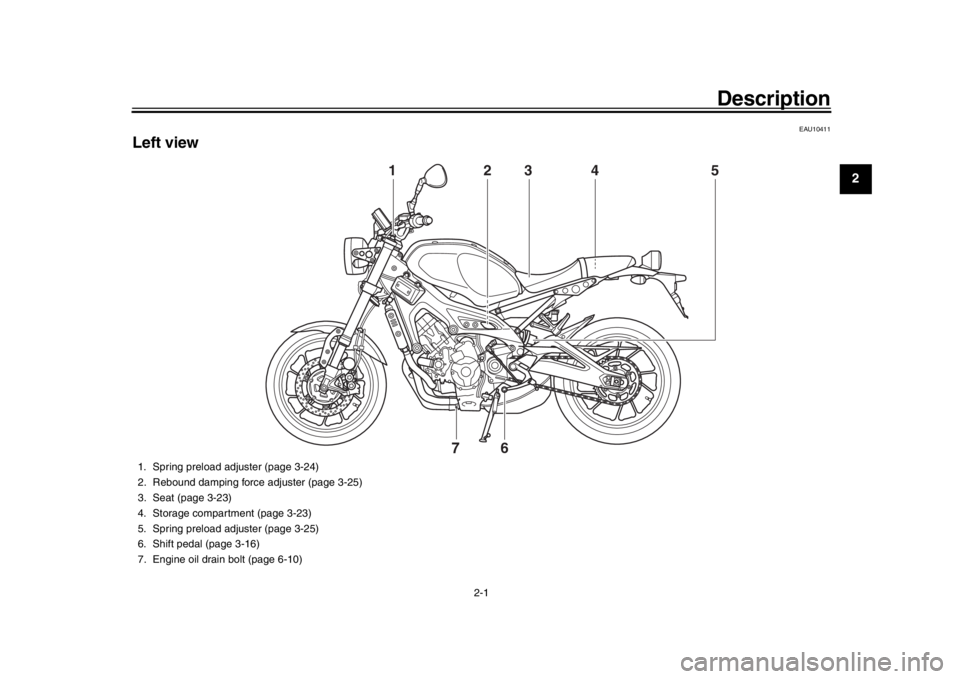
2-1
123
4
5
6
7
8
9
10
11
12
Description
EAU10411
Left view
2
1
3
4
5
6
7
1. Spring preload adjuster (page 3-24)
2. Rebound damping force adjuster (page 3-25)
3. Seat (page 3-23)
4. Storage compartment (page 3-23)
5. Spring preload adjuster (page 3-25)
6. Shift pedal (page 3-16)
7. Engine oil drain bolt (page 6-10)
UB90E2.book 1 ページ 2018年6月5日 火曜日 午後5時40分
Page 14 of 104
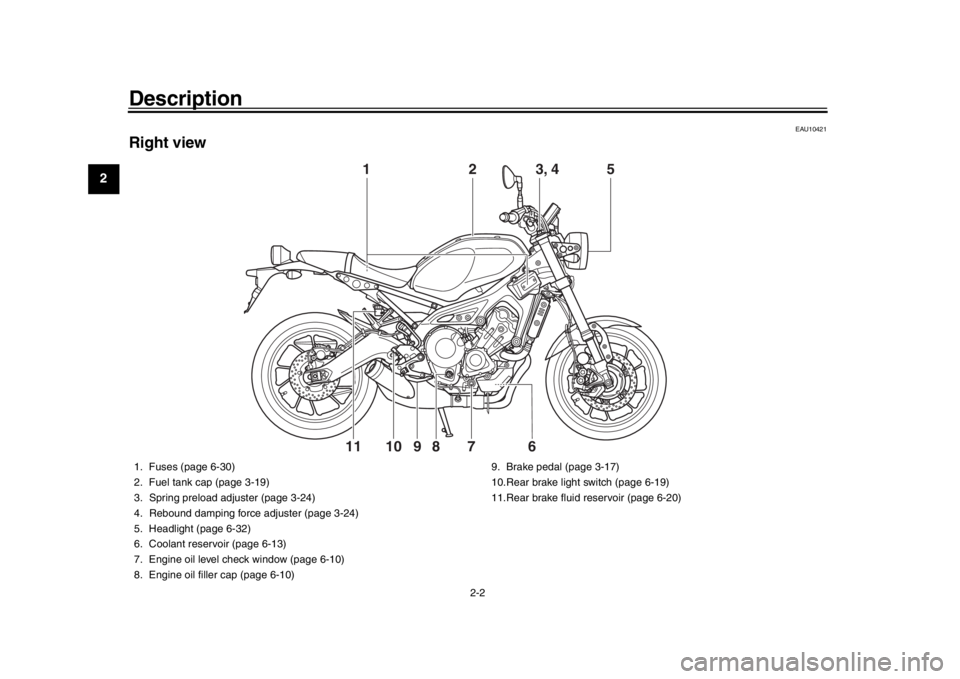
Description
2-2
12
3
4
5
6
7
8
9
10
11
12
EAU10421
Right view
2
5
8
7
9
10
6
11
1
3, 4
1. Fuses (page 6-30)
2. Fuel tank cap (page 3-19)
3. Spring preload adjuster (page 3-24)
4. Rebound damping force adjuster (page 3-24)
5. Headlight (page 6-32)
6. Coolant reservoir (page 6-13)
7. Engine oil level check window (page 6-10)
8. Engine oil filler cap (page 6-10) 9. Brake pedal (page 3-17)
10.Rear brake light switch (page 6-19)
11.Rear brake fluid reservoir (page 6-20)
UB90E2.book 2 ページ 2018年6月5日 火曜日 午後5時40分
Page 19 of 104

Instrument and control functions
3-4
1
234
5
6
7
8
9
10
11
12
EAU4939D
Indicator lights and warning
lights
EAU11032
Turn signal indicator lights “ ” and
“”
Each indicator light will flash when its
corresponding turn signal lights are flashing.
EAU11061
Neutral indicator light “ ”
This indicator light comes on when the
transmission is in the neutral position.
EAU11081
High beam indicator light “ ”
This indicator light comes on when the
high beam of the headlight is switched
on.
EAU11257
Oil level warning light “ ”
This warning light comes on if the en-
gine oil level is low.
When the vehicle is turned on, the light
will perform a circuit check (come on for
a few seconds and then go off).
If the warning light remains on after
confirming that the oil level is correct
(page 6-10), have a Yamaha dealer
check the vehicle.TIP
Even if the oil level is sufficient, the
warning light may flicker when rid-
ing up or downhill, or during sud-
den acceleration or deceleration,
but this is not a malfunction.
If a malfunction is detected, the oil
level warning light will flash repeat-
edly. Have a Yamaha dealercheck the vehicle.
EAU11447
Coolant temperature warning light
“”
This warning light comes on if the en-
gine overheats. If this occurs, stop the
engine immediately and allow the en-
gine to cool.
The electrical circuit of the warning light
can be checked by turning the key to
“ON”. The warning light should come
on for a few seconds, and then go off.
If the warning light does not come on
initially when the key is turned to “ON”,
or if the warning light remains on, have
a Yamaha dealer check the electrical
circuit.NOTICE
ECA10022
Do not continue to operate the en-gine if it is overheating.
1. Traction control system indicator light
“”
2. ABS warning light “ ”
3. Engine trouble warning light “ ”
4. Coolant temperature warning light “ ”
5. Oil level warning light “ ”
6. Left turn signal indicator light “ ”
7. Neutral indicator light “ ”
8. High beam indicator light “ ”
9. Right turn signal indicator light “ ”
10.Immobilizer system indicator light “ ”
2
13
4
5
6
7
8
9
10
ABS
UB90E2.book 4 ページ 2018年6月5日 火曜日 午後5時40分
Page 46 of 104
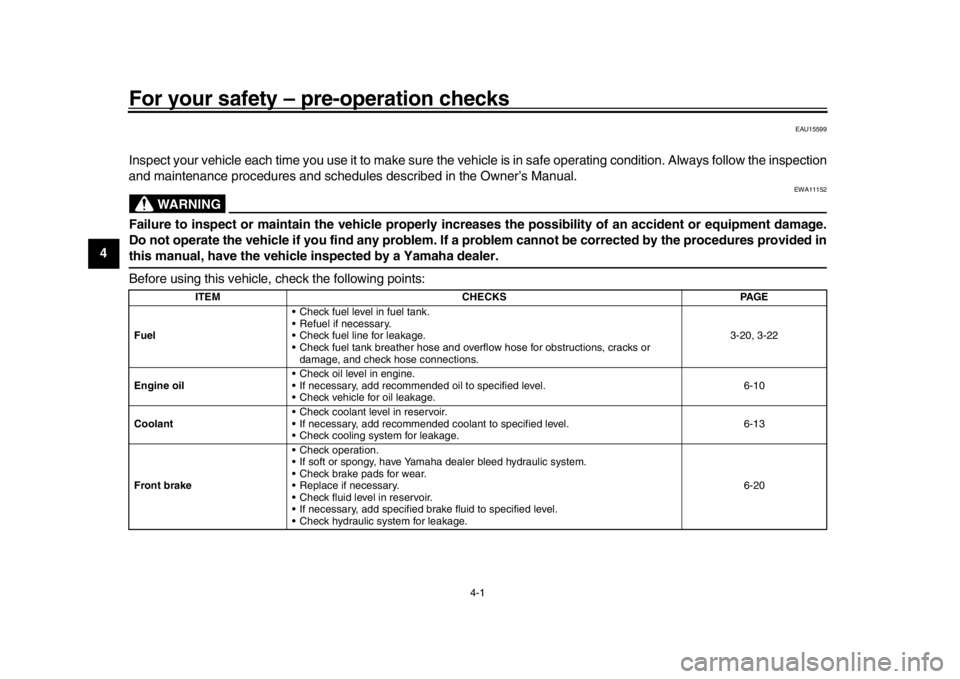
4-1
1
2
34
5
6
7
8
9
10
11
12
For your safety – pre-operation checks
EAU15599
Inspect your vehicle each time you use it to make sure the vehi cle is in safe operating condition. Always follow the inspection
and maintenance procedures and schedules described in the Owner’s Manual.
WARNING
EWA11152
Failure to inspect or maintain the vehicle properly increases the possibility of an accident or equipment damage.
Do not operate the vehicle if you find any problem. If a problem cannot be corrected by the procedures provided inthis manual, have the vehicle inspected by a Yamaha dealer.
Before using this vehicle, check the following points:
ITEM CHECKS PAGE
Fuel Check fuel level in fuel tank.
Refuel if necessary.
Check fuel line for leakage.
Check fuel tank breather hose and overflow hose for obstructions, cracks or
damage, and check hose connections. 3-20, 3-22
Engine oil Check oil level in engine.
If necessary, add recommended oil to specified level.
Check vehicle for oil leakage. 6-10
Coolant Check coolant level in reservoir.
If necessary, add recommended coolant to specified level.
Check cooling system for leakage. 6-13
Front brake Check operation.
If soft or spongy, have Yamaha dealer bleed hydraulic system.
Check brake pads for wear.
Replace if necessary.
Check fluid level in reservoir.
If necessary, add specified brake fluid to specified level.
Check hydraulic system for leakage. 6-20
UB90E2.book 1 ページ 2018年6月5日 火曜日 午後5時40分
Page 49 of 104
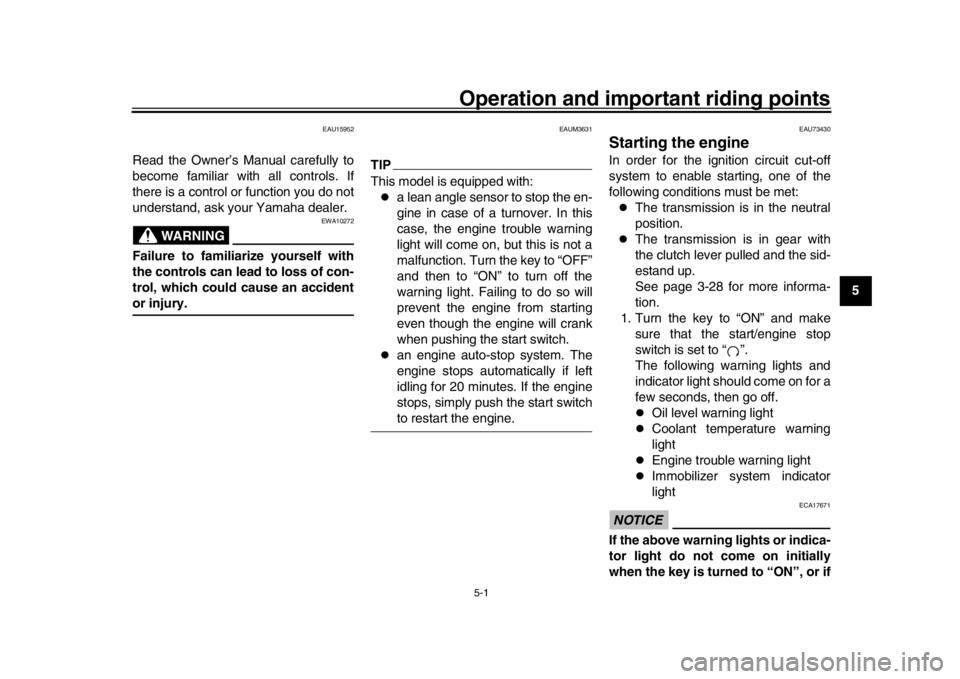
5-1
1
2
3
456
7
8
9
10
11
12
Operation and important riding points
EAU15952
Read the Owner’s Manual carefully to
become familiar with all controls. If
there is a control or function you do not
understand, ask your Yamaha dealer.
WARNING
EWA10272
Failure to familiarize yourself with
the controls can lead to loss of con-
trol, which could cause an accidentor injury.
EAUM3631
TIPThis model is equipped with:
a lean angle sensor to stop the en-
gine in case of a turnover. In this
case, the engine trouble warning
light will come on, but this is not a
malfunction. Turn the key to “OFF”
and then to “ON” to turn off the
warning light. Failing to do so will
prevent the engine from starting
even though the engine will crank
when pushing the start switch.
an engine auto-stop system. The
engine stops automatically if left
idling for 20 minutes. If the engine
stops, simply push the start switchto restart the engine.
EAU73430
Starting the engineIn order for the ignition circuit cut-off
system to enable starting, one of the
following conditions must be met:
The transmission is in the neutral
position.
The transmission is in gear with
the clutch lever pulled and the sid-
estand up.
See page 3-28 for more informa-
tion.
1. Turn the key to “ON” and make sure that the start/engine stop
switch is set to “ ”.
The following warning lights and
indicator light should come on for a
few seconds, then go off.
Oil level warning light
Coolant temperature warning
light
Engine trouble warning light
Immobilizer system indicator
light
NOTICE
ECA17671
If the above warning lights or indica-
tor light do not come on initially
when the key is turned to “ON”, or if
UB90E2.book 1 ページ 2018年6月5日 火曜日 午後5時40分
Page 51 of 104
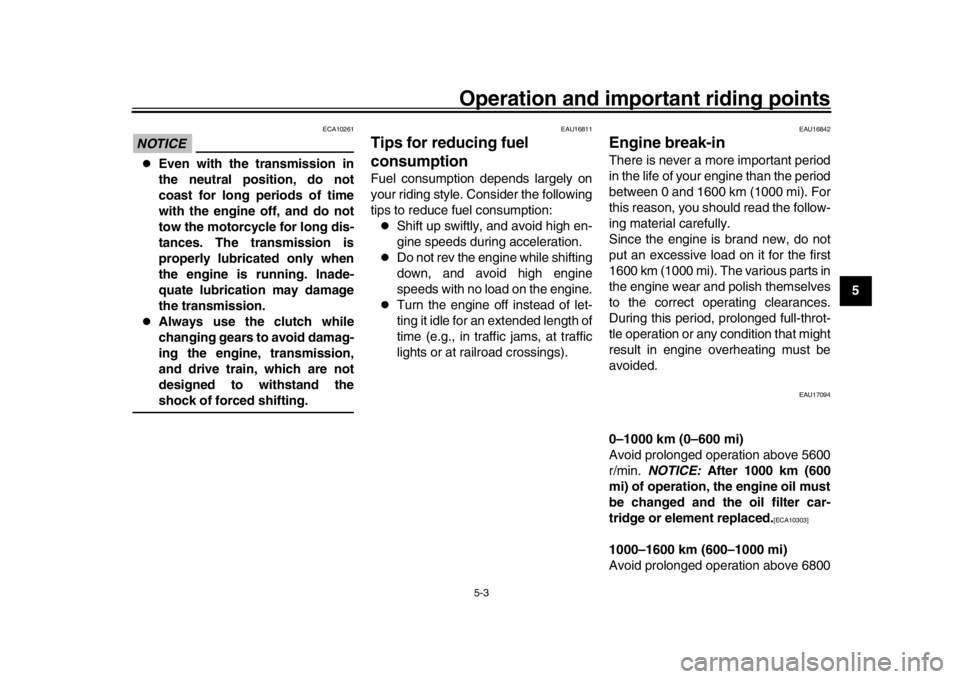
Operation and important riding points
5-3
1
2
3
456
7
8
9
10
11
12
NOTICE
ECA10261
Even with the transmission in
the neutral position, do not
coast for long periods of time
with the engine off, and do not
tow the motorcycle for long dis-
tances. The transmission is
properly lubricated only when
the engine is running. Inade-
quate lubrication may damage
the transmission.
Always use the clutch while
changing gears to avoid damag-
ing the engine, transmission,
and drive train, which are not
designed to withstand theshock of forced shifting.
EAU16811
Tips for reducing fuel
consumptionFuel consumption depends largely on
your riding style. Consider the following
tips to reduce fuel consumption:
Shift up swiftly, and avoid high en-
gine speeds during acceleration.
Do not rev the engine while shifting
down, and avoid high engine
speeds with no load on the engine.
Turn the engine off instead of let-
ting it idle for an extended length of
time (e.g., in traffic jams, at traffic
lights or at railroad crossings).
EAU16842
Engine break-inThere is never a more important period
in the life of your engine than the period
between 0 and 1600 km (1000 mi). For
this reason, you should read the follow-
ing material carefully.
Since the engine is brand new, do not
put an excessive load on it for the first
1600 km (1000 mi). The various parts in
the engine wear and polish themselves
to the correct operating clearances.
During this period, prolonged full-throt-
tle operation or any condition that might
result in engine overheating must be
avoided.
EAU17094
0–1000 km (0–600 mi)
Avoid prolonged operation above 5600
r/min. NOTICE: After 1000 km (600
mi) of operation, the engine oil must
be changed and the oil filter car-
tridge or element replaced.
[ECA10303]
1000–1600 km (600–1000 mi)
Avoid prolonged operation above 6800
UB90E2.book 3 ページ 2018年6月5日 火曜日 午後5時40分
Page 59 of 104

Periodic maintenance and adjustment
6-7
1
2
3
4
567
8
9
10
11
12
23 * Rear suspension
relay arm and
connecting arm
pivoting points Check operation.
24 Engine oil Change (warm engine before
draining).
Check oil level and vehicle for oil leakage.
25 Engine oil filter
cartridge Replace.
26 * Cooling system Check coolant level and vehicle
for coolant leakage.
Change. Every 3 years
27 * Front and rear brake
switches Check operation.
28 * Moving parts and
cables Lubricate.
29 * Throttle grip
housing and cable Check operation and free play.
Adjust the throttle cable free play
if necessary.
Lubricate the throttle grip housing and cable.
30 * Lights, signals and
switches Check operation.
Adjust headlight beam.
NO. ITEM CHECK OR MAINTENANCE JOB
ODOMETER READING
ANNUAL
CHECK
1000 km
(600 mi) 10000 km
(6000 mi) 20000 km
(12000 mi) 30000 km
(18000 mi) 40000 km
(24000 mi)
UB90E2.book 7 ページ 2018年6月5日 火曜日 午後5時40分
Page 61 of 104
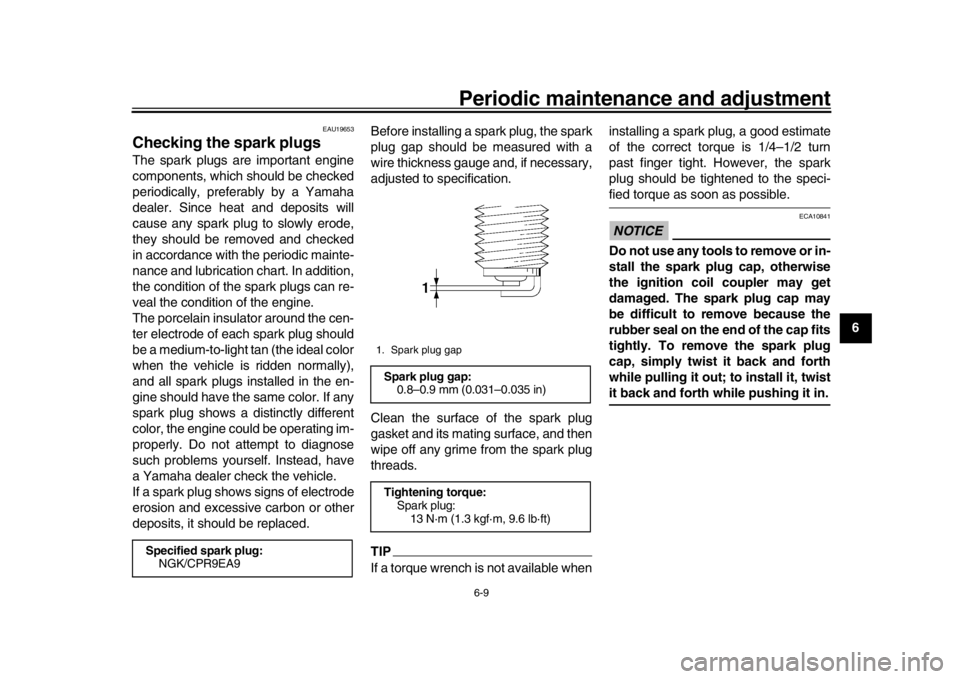
Periodic maintenance and adjustment
6-9
1
2
3
4
567
8
9
10
11
12
EAU19653
Checking the spark plugsThe spark plugs are important engine
components, which should be checked
periodically, preferably by a Yamaha
dealer. Since heat and deposits will
cause any spark plug to slowly erode,
they should be removed and checked
in accordance with the periodic mainte-
nance and lubrication chart. In addition,
the condition of the spark plugs can re-
veal the condition of the engine.
The porcelain insulator around the cen-
ter electrode of each spark plug should
be a medium-to-light tan (the ideal color
when the vehicle is ridden normally),
and all spark plugs installed in the en-
gine should have the same color. If any
spark plug shows a distinctly different
color, the engine could be operating im-
properly. Do not attempt to diagnose
such problems yourself. Instead, have
a Yamaha dealer check the vehicle.
If a spark plug shows signs of electrode
erosion and excessive carbon or other
deposits, it should be replaced. Before installing a spark plug, the spark
plug gap should be measured with a
wire thickness gauge and, if necessary,
adjusted to specification.
Clean the surface of the spark plug
gasket and its mating surface, and then
wipe off any grime from the spark plug
threads.
TIPIf a torque wrench is not available wheninstalling a spark plug, a good estimate
of the correct torque is 1/4–1/2 turn
past finger tight. However, the spark
plug should be tightened to the speci-
fied torque as soon as possible.NOTICE
ECA10841
Do not use any tools to remove or in-
stall the spark plug cap, otherwise
the ignition coil coupler may get
damaged. The spark plug cap may
be difficult to remove because the
rubber seal on the end of the cap fits
tightly. To remove the spark plug
cap, simply twist it back and forth
while pulling it out; to install it, twistit back and forth while pushing it in.
Specified spark plug:
NGK/CPR9EA9
1. Spark plug gapSpark plug gap:0.8–0.9 mm (0.031–0.035 in)
Tightening torque: Spark plug:13 N·m (1.3 kgf·m, 9.6 lb·ft)
UB90E2.book 9 ページ 2018年6月5日 火曜日 午後5時40分
Page 62 of 104

Periodic maintenance and adjustment
6-10
1
2
3
4
56
7
8
9
10
11
12
EAU36112
CanisterThis model is equipped with a canister
to prevent the discharging of fuel vapor
into the atmosphere. Before operating
this vehicle, make sure to check the fol-
lowing:
Check each hose connection.
Check each hose and canister for
cracks or damage. Replace if dam-
aged.
Make sure that the canister breath-
er is not blocked, and if necessary,
clean it.
EAU1990D
Engine oilThe engine oil level should be checked
regularly. In addition, the oil must be
changed and the oil filter cartridge re-
placed at the intervals specified in the
periodic maintenance chart.NOTICE
ECA11621
In order to prevent clutch slip-
page (since the engine oil also
lubricates the clutch), do not
mix any chemical additives. Do
not use oils with a diesel speci-
fication of “CD” or oils of a high-
er quality than specified. In
addition, do not use oils labeled
“ENERGY CONSERVING II” or
higher.
Make sure that no foreign mate-rial enters the crankcase. To check the engine oil level
1. After warming up the engine, wait a few minutes for the oil to settle.
2. With the vehicle on a level surface, hold it upright for an accurate read-
ing.
3. Look at the check window located at the bottom-right side of the
crankcase.
TIPThe engine oil should be between theminimum and maximum level marks.
4. If the engine oil is at or below the minimum level mark, remove the
1. Canister
2. Canister breather hose
1
2
Recommended engine oil: See page 8-1.
Oil quantity: Oil change:2.40 L (2.54 US qt, 2.11 Imp.qt)
With oil filter removal: 2.70 L (2.85 US qt, 2.38 Imp.qt)
1. Engine oil filler cap
2. Engine oil level check window
3. Maximum level mark
4. Minimum level mark
1
2
34
UB90E2.book 10 ページ 2018年6月5日 火曜日 午後5時40分